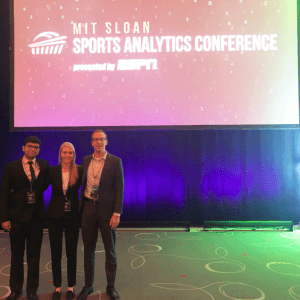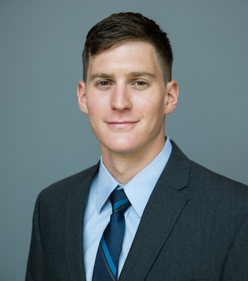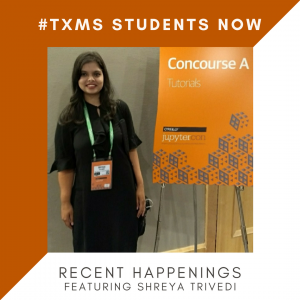 Over the weekend of March 1-3, we attended the MIT Sloan Sports Analytics Conference in Boston, MA. The goal of the conference is to provide a forum to discuss the increasing role of analytics in the sports industry. As MSBA students, it was exciting to have the opportunity to listen to industry professionals speak about how analytics are being applied to various functions of the sports industry.
Over the weekend of March 1-3, we attended the MIT Sloan Sports Analytics Conference in Boston, MA. The goal of the conference is to provide a forum to discuss the increasing role of analytics in the sports industry. As MSBA students, it was exciting to have the opportunity to listen to industry professionals speak about how analytics are being applied to various functions of the sports industry.
The conference itself was a confluence of people from around the world representing many different sports at both the amatuer and professional level. The main reason for attending the conference was to learn about how analytics concepts that we have discussed in the program are being applied to a myriad of different sports in order to create more “beautiful” games, to better understand fan bases, to assist users in the world of sports betting, and to help facilitate decision making for coaches and management alike.
There was knowledge to be gained all around- from the panels, talks, and research paper presentations to casual chats with fellow attendees. We enjoyed meeting many different people involved in the world of sports analytics, from seasoned professionals to current students. By attending the Sloan Conference, we were able to network with various professional sports teams and league offices such as LA FC, FC Barcelona, the Buffalo Bills, and the Golden State Warriors. We even got to catch up with some MSBA alumni, including Drew Lieberman at the Miami Dolphins and Nick Fleder at the Indianapolis Pacers.
When considering what we learned of the sports industry and the exploding use of data and analytics in it, it’s clear that our MSBA curriculum is most certainly preparing us for such an industry and equipping us to adapt to the ever-evolving trends in analytics in general. Topics that arose at the conference include deep learning and neural networks, managing databases, social media analytics and ticket pricing/revenue management. This conference allowed us to see the importance of these analytics concepts as well as get a chance to see some of the practical applications in sports.
Additionally, the MSBA program prides itself on training “quantitatively capable storytellers” and preparing its students to be able to effectively communicate their findings to peers, stakeholders, and clients alike. The panels and presentations we saw all weekend were both inspirational and instructional in showing us how to present data insights to audiences with varying levels of fluency in statistics and machine learning concepts.
A few presentations in particular stood out. The first was “Beautyball: Using Analytics to Build Beautiful Games” by ESPN NBA Analyst (and current UT Professor Kirk Goldsberry). Using the framework of the NBA’s evolving shot distribution – fewer post-ups, more three pointers – Goldsberry asserted that sports leagues need to consider how they want their games to look and then use analytics-based methods to refine their rules to get there. One example would be identifying a reasonable proportion of shot attempts that should be three-pointers. The NBA could then move the three-point line back a distance where the new efficiency of the shot would incentivize teams to attempt them at the desired rate. Goldsberry is known for his beautiful visualizations, and he was a great example of how to effectively present data.
Among the more technical presentations, we were fascinated by “Going Beyond Tracking Data: Using Body-Pose for Next Generation Analytics” presented by Sujoy Ganguly, the head of Data Vision at STATS. Previously, STATS was only able to track player position in x-y coordinates if their SportVU cameras were installed in stadiums. Ganguly demonstrated how they can now use neural networks to analyze television broadcasts of sporting events to track each player’s position and body pose – including the position of their limbs. He even showed the famous footage of Michael Jordan’s game winning shot in the 1998 NBA Finals and overlaid the player positioning tracking data they were able to pull from the footage. This could be a revolutionary advancement, and it was great to see a new application of the neural network image recognition methods that we learned about in Professor Ghosh’s Advanced Predictive Modeling course.
Overall, the conference was a rewarding experience for this trio of MSBA students. It is certainly a must attend for students of future cohorts who have not only a passion for analytics but a love for sports and competition, and want to play their parts in the making of champions.
 We had the amazing opportunity to attend the 5th Annual RE.WORK Deep Learning Summit in San Francisco held on 24-25th January this year. The conference had the most captivating sessions lined up by researchers and working professionals from organizations like Facebook, Google Brain, Uber AI Labs, Walmart Labs, GE, Samsung, AIRA working extensively to empower the blind and numerous more. The sessions also included workshops which were really constructive in getting us acquainted with alternative tools we can use for our ML oriented projects. This year conference was also special as in addition to Deep Learning and AI Assistant directed sessions, there were numerous other sessions revolving around Environment & Sustainability, Ethics & Social Responsibility, Futurescaping, Investors & Startups and Technical Labs, Education & AI, Industry Applications; 8 new stages that were never seen before for the Deep Learning Summit. (Pictured: MSBA- Serena Du, Avani Sharma, Apoorva Reddy, Atindra Bandi, Sagar Chadha, Akhilesh Narapareddy)
We had the amazing opportunity to attend the 5th Annual RE.WORK Deep Learning Summit in San Francisco held on 24-25th January this year. The conference had the most captivating sessions lined up by researchers and working professionals from organizations like Facebook, Google Brain, Uber AI Labs, Walmart Labs, GE, Samsung, AIRA working extensively to empower the blind and numerous more. The sessions also included workshops which were really constructive in getting us acquainted with alternative tools we can use for our ML oriented projects. This year conference was also special as in addition to Deep Learning and AI Assistant directed sessions, there were numerous other sessions revolving around Environment & Sustainability, Ethics & Social Responsibility, Futurescaping, Investors & Startups and Technical Labs, Education & AI, Industry Applications; 8 new stages that were never seen before for the Deep Learning Summit. (Pictured: MSBA- Serena Du, Avani Sharma, Apoorva Reddy, Atindra Bandi, Sagar Chadha, Akhilesh Narapareddy) MSF Class of 2019 student Imri Ganiel was one of two recipients of NCAA Postgraduate Scholarships, alongside fellow swimmer Madisyn Cox. The one-time $7,500 scholarships are awarded after each corresponding sport season (fall, winter and spring). The NCAA awards 29 scholarships to men and 29 scholarships to women for each term. It is just the fifth time in UT history that a pair of Longhorns have claimed this honor in the same calendar year and the first since 1988. Ganiel and Cox mark the 27th and 28th athletes at the University of Texas to earn this prestigious scholarship.
MSF Class of 2019 student Imri Ganiel was one of two recipients of NCAA Postgraduate Scholarships, alongside fellow swimmer Madisyn Cox. The one-time $7,500 scholarships are awarded after each corresponding sport season (fall, winter and spring). The NCAA awards 29 scholarships to men and 29 scholarships to women for each term. It is just the fifth time in UT history that a pair of Longhorns have claimed this honor in the same calendar year and the first since 1988. Ganiel and Cox mark the 27th and 28th athletes at the University of Texas to earn this prestigious scholarship.



 The Master of Science in Marketing (MSM) at the McCombs School of Business ranked #3 among “Best Master’s in Marketing Degree for 2017) by
The Master of Science in Marketing (MSM) at the McCombs School of Business ranked #3 among “Best Master’s in Marketing Degree for 2017) by 
 Catherine King, BHP
Catherine King, BHP
 What piqued your interest in this conference?
What piqued your interest in this conference?